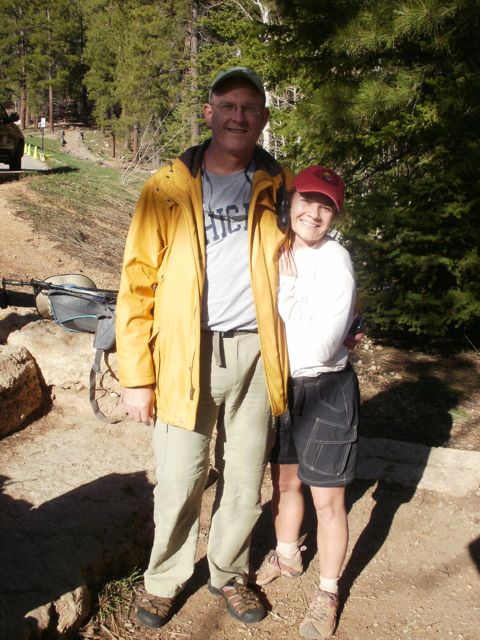As refreshing as this river water may look, most hikers who step foot below the Rim won’t see any water at all. Â That is why every hiker in the Grand Canyon in the summer (when it is 110 degrees in the shade) Â must plan for Heat, Hydration, and strenuous exercise in the desert’s Low Humidty. Â A quick review from my Mental and Physical Training Tips Page:
Heat:
It will be 100 – 120 degrees in the canyon.  This is a dry heat in low humidity where 110 degrees in the shade equals 130 degrees on the trail with the microwave effect of the sun and black rocks. Start by assessing what you know about yourself in high heat situations, do you ‘crash’ even though you are getting plenty of water and salt?
You will need to educate yourself on Heat Exhaustion and Heat Stroke. On a basic level, high heat conditions can throw a wrench into your Autonomic Nervous System and blood pressure regulation mechanisms that can make you dizzy, lightheaded, or even black out. If you get lightheaded when you stand up out of bed, get frequent headaches, feel foggy headed or tired/lethargic if you sit still very long, if heat “wipes you out”, then you may be sensitive to the heat in the Canyon. These things can be blood pressure regulation issues, and heat is a stressor that magnifies these symptoms.  In everyday life these symptoms are annoyances people live and work around, but in the Canyon’s extreme conditions these issues can be deadly serious and life threatening.
If you have any heat related symptoms or intolerances, talk to your doctor about your health before stepping one foot into the Grand Canyon.
The NPS advises not to hike during the heat of the day, which is between 10 AM and 4 PM, and everyone should listen to them.
Hydration:
Constant water hydration, salt, and electrolyte replacement is critical to fight dehydration. Dehydration is the gateway to heat exhaustion, heat stroke, and can affect altitude sickness. Learning to drink constantly is a habit you must form during your training or you will forget to do it in the Canyon. If you wait to drink until you feel thirsty, you will already be in the early stages of dehydration and you will not be able to make up that deficiency. On this desert hike you can lose anywhere from 1 to 2 liters of water through undetectable sweat alone each hour.
Drink even though you are not thirsty, and try out several flavors of electrolyte powder drinks or pills well before any hike.  Get used to your electrolyte flavors and drink them warm out of your backpacks and plastic bottles to see if you can stand the taste.  Better yet, try drinking them HOT because that is the temp your liquids will reach in the Canyon.  The last thing you want to do is to try out a new drink mix and your backpack for the first time on the trail, that might make you gag when it’s hot.  I keep my  3 liter backpack bladder full of regular water, and take 2 smaller bottles to mix electrolytes in along the way. This way if hours into the hike my flavor starts making me ill I still have options and regular water.
Use the buddy system by reminding each other to drink and consume salt.  In the Grand Canyon it is easy to get distracted by the natural beauty and rigors of the hike, and fall behind on your liquid consumption. You should be drinking and peeing all the time, all day long. Your fellow hikers should be drinking and peeing too. Your lives are at risk if anyone gets dehydrated.
You need to look up the dangerous condition called Hyponatremia; water intoxication. It is too much water, not enough salt, and you need to know about it because it can lead to brain swelling, organ failure, coma, and death. You have to drink smart in the Canyon.
Check the NPS Backcountry website for weather warnings, hiking tips, and water sources but be aware that clean water sources within the Grand Canyon are never guaranteed and the pipe breaks all the time. Â It is your responsibility to take all of the water you will need on any day hike, or be familiar with water purification, filtering, and potential water sources for multi day hikes.
Low Humidity:
The Low Humidity of the desert means your sweat will evaporate very, very fast. In the Grand Canyon, you will not even realize you are sweating because your body will be acting differently than it does at home. This can be confusing because you are hiking hard for hours and yet you are not even “breaking a sweatâ€. But, you will be losing fluids at a higher rate than you are used to back home and this makes you more prone to dehydration.
The dryer climate of the desert speeds the evaporation from our skin and breath. Most people come from places around the country where humidity ranges from 50 – 90% at any time of year. The humidity in the desert hovers around 10% or lower. This is a big change and your external mechanisms (sweat rolling down your face) may not be present. If you can’t train in a low humidity climate, then at the very least search and look up some basics on extended exercise in low humidity climates.
—
Happy, fun, safe summer hikes in the Grand Canyon are the result of preparedness, training, and proper equipment. Â And no matter how much you plan or think you’re ready for anything – the Grand Canyon can and will throw you a curve ball. Â Be ready, hike smart!!

